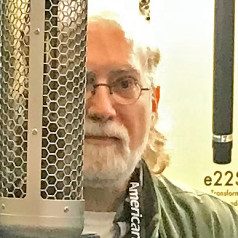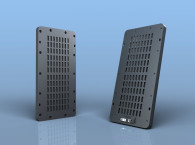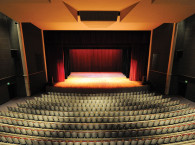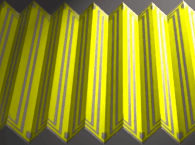
The Altec Lansing Voice of the Theatre series was one of the innovations coming out of the post-war era. John Hilliard at Altec Lansing took many of the acoustical innovations that came out of the World War II effort and developed a new loudspeaker design for large halls that was completely different from the Western Electric cinema systems of the pre-war era.
First launched by Altec in 1947, the designs were available in a number of different two-way configurations, built on the same building blocks with Model 515 woofers and the new 288 high-frequency compression drivers, with and without side baffles. Within a few years, they had introduced a number of additional configurations including the classic A7 — a compact version designed for smaller cinemas but which found its way toward becoming perhaps the most popular sound reinforcement speaker of the 1950s through the 1970s.
Today, the A7 is one of the most sought-after speakers for home audio in Japan, in part because real estate is so expensive in Japan that to be able to say you have a pair of A7s is to imply that you have a living room that is so large that it requires a pair of A7s to fill it. And they still can be found in sound reinforcement service as can many of the larger Voice of the Theatre systems.
This article discusses some of the things that you should know about the Voice of the Theatre system for theater or auditorium installations. It is by no means authoritative, it’s just an overview of what is out there, along with some of my personal thoughts about the system.

Bass Horns
What makes these speakers interesting today, and what makes them different from nearly anything currently made, is that they are bass horns. There is a high-frequency horn on top (a sectoral horn that at the time gave the best pattern control), but the low frequencies are also produced by a large folded horn driven by large woofers specifically intended for high-compression applications. This was in many ways the precursor to the W-Bin bass cabinets of the 1970s, but the direct-firing woofer made for response that remained flat up into midrange frequencies.
The bad news about this is that very low bass extension was not possible, because with a bass horn, the lowest possible frequency was limited by the horn’s exit width. Once the wavelength becomes wider than the horn exit, the response precipitously drops. One thing that could be done was to put multiple horns together making a super-wide horn (as used in the Altec X-1), and another was to add baffles to the side of the cabinet, which effectively increased the size of the horn as used in a variety of cabinets and available as retrofits for many others.
The good news about this is that the efficiency is very high because the coupling between the woofer and the outside air is almost perfect above that cut-off frequency. For example, 100mW out of a Walkman headphone jack will produce room-filling sound in a large auditorium, and two 6L6 tubes putting out 20W are enough for fairly dynamic film soundtracks.
Another point that should be made is that in 1947, the physics of horn speakers was very well understood. Engineers still did not have a grip on all the parasitic resonances bouncing around inside big horns, but the fundamental physics of operation was no longer in question. This was not the case for bass reflex speakers, which had to wait until Neville Thiele and Richard Small’s paper was published in 1961. So, unlike the sealed and the vented box designs of the era, the Voice of the Theatre speakers were systematically designed.

Amplifiers
One of the major advantages of these speakers when they were new was that they were so efficient. Back in the days when the largest power pentode you could buy was a 6L6, amplifier power was expensive and amplifier distortion at high powers was quite high. As Paul Klipsch always claimed, the key to reducing the total system distortion back in those days was to improve speaker efficiency, more than to improve the speaker linearity.
The problem is that by the 1970s, amplifier power was cheap, and what was worse, many of the more popular power amplifiers were biased in such a way that the distortion at low power was much higher than the distortion at maximum power.
That is, the primary amplifier distortion mechanism was crossover distortion, and some people argued that this was a consequence of advertisements and datasheets listing full power distortion, causing a push for engineers to try to reduce full power distortion at the expense of all other specifications. Whatever was the cause of it, the end result was terrible, terrible sound. Take a Phase Linear or South West Technical Products Corp. (SWTPC) amplifier from the 1970s and put it on an A-7 — you get room-filling volume with a fraction of a watt.
Unfortunately when delivering a fraction of a watt, these amplifiers produced horrible shrill and shrieky sounds. This gave the Altecs an undeservedly bad name at the time, when in fact it was the amplifier that should have been blamed.

Phase Coherency
These systems are intended to be listened to at a distance, in a wide and fairly flat room with a tapered floor, so that most of the listeners are in the same vertical plane as the speaker. They might be a bit higher or lower if they are seated in the front or back rows but they won’t be too far off. As a consequence, the phase coherency in the horizontal plane was not something about which the designers of these speakers ever cared.
Right on-axis, the listener has the same distance to both the woofer and tweeter horns, but move substantially up or down and this changes. Several feet of distance between the woofer and the tweeter in most of the Altec models makes this a very serious problem for use outside of a theater.
The A-7 was available with an inverted configuration where the high-frequency horn could be mounted inside the bass horn instead of being mounted on top of the box. Although still far from a coaxial design, this gave much better phase coherence and is a huge improvement in an environment where listeners may not be on the same horizontal plane as the loudspeakers.
Any A-7 being used today should be set up as an inverted cabinet with the horn mounted within the box. Not only does this make it more rugged and roadable, but the phase alignment is far better. Unfortunately, the other Voice of the Theatre systems do not permit this configuration. In all cases, the horn/woofer alignment needs to be adjusted for the room so that the acoustic centers of both have the same distance to the listener in the middle of the room. The procedure for doing this can be found in the manuals.
The Various Models
I’m not going to list all the dozens of different models made over the years, other than to say that they all have 1” or 1.4”compression drivers with sectoral horns on top and bass horns with 15” cone woofers on the bottom. They also either have 800Hz or 500Hz crossovers. There are some with a single 1” driver on top, and a single 416 on the bottom with an 800Hz crossover. At the other end of the spectrum, there is the A1X with four 1.4” compression drivers on top and six 515 woofers on the bottom. This is what I mean by a “modular system” in that there are a huge variety of different products that were sold by mixing and matching.
In addition to the standard line, Altec also sold some special order items with nonstandard configurations. (For instance, two 1” compression drivers into a single manifold was a curious arrangement that you will not see in the catalog.) And, given how long the systems were sold, there have also been a large number of curious hybrids that people have built with Voice of the Theatre components, many of which were passed off as production speakers but actually were not.
It’s not my intention to describe all the combinations available, and the original Altec documentation is available online if you want to look them up. The A-5 and A-7 speakers were the most common, although they both came in several different variants over the years.
In addition, a lot of Altec products that use these drivers or similar drivers are frequently sold as Voice of the Theatre speakers even when they are not. A tremendous variety of similarly sized Altec speakers are sold today on eBay as A-7s, when they were never sold originally as A-7s and do not have a component lineup that was ever used in the A-7s. So make sure you know what you are buying.
My personal feeling is that the speakers using the 1” compression drivers with a 500 Hz crossover sound better than the ones using the 1.4” driver, if only because it keeps the crossover artifacts farther out of the vocal band and the driver seems less prone to parasitic resonances in the top octave. (Also, availability of high-quality aftermarket diaphragms for the smaller compression drivers is better and that can lead to better sound as well.) On the other hand, a friend of mine who does cinema sound installations does not like the 1" drivers because they are comparatively delicate.
He says every time he has ever encountered one, the diaphragm was blown and that he much prefers the 288. There is something to be said for that, because any driver will sound better than a blown one. And in sound reinforcement applications, it is already far too easy to damage the 288 with extreme transients.
It is true that Altec overstated the ability of these speakers, and it was not unusual to see systems installed that were undersized for the room. Take the manufacturer’s recommendations for acceptable auditorium sizes with a grain of salt.
If you have a horn designed for a 1.4” driver and you want to change to a 1” driver, the appropriate adaptor is Altec part 21216. Be sure you have enough power handling in the smaller driver to get enough sound for the room, though. Note that there also are two different phase plug designs for the 1” drivers — the original circumferential plug and the new Tangerine one.
The two sound a little bit different and I personally think both of them are fine as long as you make sure that you use all of the same kind. Since so many systems out there were assembled from bits and pieces, this is an important thing to check.

The Treble Horn
All of these drivers were available with a variety of diaphragms from horrible phenolic things to conventional aluminum ones. There were various specialty ones with names like “Pascalite” and “Symbiotik.” I won’t give details on any of these because you don’t want any part of them. It doesn’t matter what diaphragms you have in there because it’s almost certainly in poor condition. Put new ones in.
Materion Truextent makes replacement diaphragms for the smaller compression drivers, which have better high-frequency response, lower distortion, and better power handling. There is no reason not to be using them other than price, and the price is likely worth it in a commercial installation.
A number of companies are making third-party replacement diaphragms of varying quality. Some are very bad, and appear under a variety of different names — sometimes names that have been used for other manufacturer’s diaphragms in the past. I would urge you to avoid these if at all possible.
Note that these drivers were sold with 8Ω, 16Ω, and 24Ω diaphragms, so make sure to get a replacement of the same impedance, if you are using a passive crossover like the original configuration. Some of the Altec compression drivers, most notably almost all of the 288 drivers, have alnico magnets, which can suffer from loss of magnetism over the years especially if dropped or mechanically shocked. These can be remagnetized by Great Plains Audio, which has the remaining Voice of the Theatre parts inventory from Altec as well. I don’t know anyone else set up to remagnetize them. The later drivers use ferrite magnets and are more stable.
In addition to upgrading the diaphragm, there are two very popular modifications for the top end. The first is to remove the bug filter from the horn’s throat. The bug filter is a metal mesh mounted into the front of the compression driver to keep insects out. Removing it makes the device more delicate and prone to damage from insects and debris, but the improvement in high-end detail at high levels is considerable and the expense is nil.
The second modification is to damp the horn so it no longer rings. Strike it with a screwdriver and the stock horn rings like a bell. Put automotive undercoating on the outside or a mixture of tar and sand, and the ringing will stop. This is not expensive and is a tremendous improvement in the top end.
Some people have advocated cutting the braces at the horn’s mouth and filling in the broken parts with RTV, so as to isolate the braces from the horn itself mechanically. This emulates some of the later Altec horn designs. I have not tried it and cannot recommend it. It seems difficult mechanically.

Bass Horns
If you knock on the side of the cabinets, you will find that the bass horns on these systems severely ring. They sound hollow, rather than giving a dull thud. Stiffening the box with external sheets of Baltic Birch can help a lot, along with adding internal wood blocks for bracing. I have seen some of these cabinets where internal bracing was added with cheap pine 2 × 4s and that seems like a good improvement, if you are on a budget.
Of course, if these systems are being flown, you have to worry about structural support and about adding too much weight. But if they are on the normal platforms behind a projection screen there’s no reason not to add as much weight as needed to make them go thunk instead of sounding hollow when struck.
Often as these cabinets age, the wood shrinks and a gap will appear along the bottom edge of the bass horn. Filling that gap with RTV or wood filler will help a lot. Some people have used Bondo or tar behind the curved flare sections to damp them down and keep them from ringing. Other people have installed a wooden baffle and pumped the area between the baffle and the flare with expanding polyurethane foam. I do not know how effective this is — on some of the smaller speakers, those sections do not ring much when knocked with the knuckles, but I could see this being a help on the larger models with longer unsupported sections where the flare ringing is a serious problem and a big source of midrange mud. I’d pick Bondo as the first way of dealing with that since it seems like the easiest one to undo if it is a problem.
Wings
Many of these speakers had “wings” or bass baffles on the side of the cabinet. If yours do not, adding them is an easy way to get nearly an octave better bass extension for minimal cost. Altec published plans for all of the Voice of the Theatre cabinets, including plans for the wings. Use a high-density plywood (e.g., Baltic Birch) if you can afford it. The majority of installations never used these wings, which is a shame since they are an easy upgrade. However, this is not of much use for a system that has to go on the road.
Crossover
The existing crossover is a first-order (6 dB/octave) filter using an iron core inductor on the bottom end and an oil capacitor on the top end. It is strongly recommended that you ditch it and biamp these speakers using a modern active crossover.
If you cannot biamp, consider replacing the crossover with a modern design. In John Stronczer’s Sound Practices article from 1990, he details two modern crossover designs using second-order filters, and I recommend either one of them. Do note that some of these speakers were built for 16Ω or 24Ω operation, in that case components need to be scaled up appropriately.
If you absolutely must use the first-order crossover, at least replace the capacitors with modern film types and the inductors with air core inductors that won’t easily saturate. But really, you want to biamp if at all possible.

Repairs and Modifications
Please watch out for aftermarket parts. Although I highly recommend Radian Audio Engineering and Truetexent’s aftermarket diaphragms for the 1” throat drivers, there are some companies selling some very doubtful replacements. I do not know of a good Altec 288 replacement diaphragm right now other than the one from Altec (although the situation may have improved since I last looked). There is a Taiwanese supplier making a 288 replacement diaphragm, which has serious mid-range problems.
The same goes for replacement cones for the 416 and the 515 woofers. The aftermarket cones all appear to be far less rigid than the originals and will break up at normal listening levels. The aftermarket cloth surrounds appear to be okay, however. These aftermarket components have often been sold fraudulently as being original Altec material, so watch out.
If you see the Altec 30904 attenuator box on any of the Voice of the Theatre speakers, remove it. It was intended for some of the studio monitor systems, but a lot of people installed them into A-7s for rock band use. Take them out when you’re taking out the crossover. If you can’t afford to upgrade the crossover yet, take them out beforehand.
Conclusion
The Altec Voice of the Theater series was a milestone in loudspeaker design and these speakers can still perform well in a large auditorium today. They remain an excellent choice for cinema systems, but many of the speakers are suffering from deferred maintenance issues after so many decades of sitting unattended behind a screen. Even well-maintained ones can benefit from some upgrades. Since there were so many different models of these speakers, there is a choice for nearly any large hall. aX
This article was originally published in audioXpress, September 2020.

Resources
Altec Corp., “Construction Plans for Low-Frequency Enclosures,” Altec Lansing Applications Notes AN-11,
http://alteclansingunofficial.nlenet.net/publications/techletters/AN-11_EnclosurePlans.pdf.
A. Budmaieff, “Loudspeaker Enclosures, Their Design and Use,” Altec Corp., Catalog No. AL 1307-3.
J. Markwart and J. Tucker, “Altec Voice of the Theater Speakers for Hi-Fi,” Sound Practices, Summer 1993.
J. Stronczer, “La Voice of the Theater Chez Nous: Taming the Altec A5 Classic for Domestic Use,” Sound Practices, Volume 2, Issue 11.
Great Plains Audio (Great Plains Audio was born out of the Altec Lansing corporation in 1998)
www.greatplainsaudio.com
Online store: www.great-plains-audio.myshopify.com
About the Author
 Scott Dorsey has a degree in electrical engineering, during the pursuit of which he worked in the broadcast and recording industries. After several years working at a major studio, he took a job with a defense contractor. This left him time to do live concert recording for acoustical music and to design and build audio devices for personal use and on contract to several audio manufacturers and importers. Scott Dorsey is a regular contributor to several audio magazines. He has been publishing equipment reviews and DIY projects since the mid-1980s. He is probably best known in the general audio community for his retrofit electronics designs in inexpensive Oktava, AKG, and Feilo microphones.
Scott Dorsey has a degree in electrical engineering, during the pursuit of which he worked in the broadcast and recording industries. After several years working at a major studio, he took a job with a defense contractor. This left him time to do live concert recording for acoustical music and to design and build audio devices for personal use and on contract to several audio manufacturers and importers. Scott Dorsey is a regular contributor to several audio magazines. He has been publishing equipment reviews and DIY projects since the mid-1980s. He is probably best known in the general audio community for his retrofit electronics designs in inexpensive Oktava, AKG, and Feilo microphones.





